2018-05-31 - Nº 161
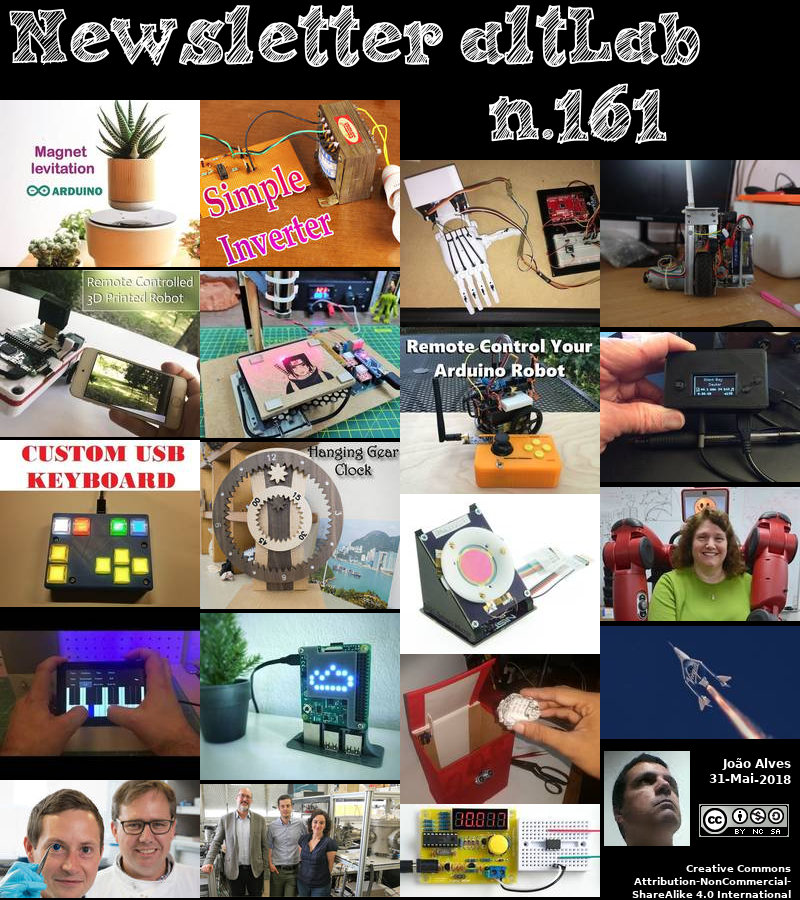
Editorial
Esta é a Newsletter Nº 161 que se apresenta com o mesmo formato que as anteriores. Se gostar da Newsletter partilhe-a!
Todas as Newsletters encontram-se indexadas no link.
Esta Newsletter tem os seguintes tópicos:
Faz hoje anos que nascia, em 1744, Richard Lovell Edgeworth. Este Inglês-irlandês foi inventor de inovações mecânicas, incluindo uma tentativa de comunicação telegráfica (possivelmente a primeira), um velocípede, um carro medidor, um cortador de nabos, máquinas agrícolas melhoradas e fez igualmente descobertas no campo da electricidade. No final da década de 1790, ele propôs o tellograph para "transmitir inteligência secreta e rápida" usando 30 torres altas espaçadas entre Dublin e Galway (130 milhas). Retransmitidos de torre em torre usando grandes ponteiros triangulares, as mensagens codificadas poderiam chegar a Dublin em apenas oito minutos. Infelizmente, a fraca visibilidade devido ao tempo condenou a ideia.
Faz também anos hoje que nascia, em 1852, Julius Richard Petri. Este médico e bacteriologista alemão é conhecido pelo seu nome dado à placa de Petri. Trata-se de um prato cilíndrico, raso, feito de plástico ou vidro com uma cobertura, usado para culturas de tecidos e para manter meios sólidos para cultura e sub-cultura de bactérias. Petri desenvolveu-o para uma técnica de clonagem de cepas bacterianas usando um declive de ágar e sub-cultura no seu prato, reconhecendo diferentes colónias bacterianas e novamente sub-cultivando.
Faz igualmente anos hoje que nascia, em 1930, Ron Toomer. Este Engenheiro americano ficou conhecido por ter sido um lendário criador de montanhas-russas de aço. O seu início de carreira foi na indústria aeroespacial, onde ajudou a projectar o escudo térmico para a nave espacial Apollo e também se envolveu com os primeiros lançamentos de satélites da NASA. Em 1965, ele juntou-se à Arrow Development Company para aplicar a tecnologia de aço tubular ao projeto Runaway Mine Ride, a primeira montanha-russa de aço do mundo. Abriu no ano seguinte no Six Flags sobre o Texas. Em 1975, ele projectou o Corkscrew da Roaring 20 para a Knott's Berry Farm, introduzindo as primeiras voltas de 360°, na verdade dois deles. Mais tarde, o seu projecto incluiu sete inversões na montanha-russa Shockwave para o Six Flags Great America. Ele produziu mais de 80 montanhas-russas antes de se aposentar em 1998.
Por fim, faz anos hoje que nascia, em 1931, John Robert Schrieffer. Este físico americano partilhou (com John Bardeen e Leon N. Cooper) o Prémio Nobel de Física de 1972 por desenvolver a teoria do BCS (para suas iniciais), a primeira teoria microscópica bem-sucedida da supercondutividade. Embora descrito pela primeira vez por Kamerlingh Onnes (1911), nenhuma explicação teórica foi aceita. Explica como certos metais e ligas perdem toda a resistência à corrente eléctrica a temperaturas extremamente baixas. O principio da teoria do BCS é que a temperaturas muito baixas, sob certas condições, os electrões podem formar pares ligados (pares de Cooper). Este par de electrões actua como uma única partícula na supercondutividade.
Na semana que passou a Intel apresentou a nova geração do Intel Optane DC. Trata-se de uma nova classe de memória e tecnologia de armazenamento desenhada para extrair mais valor dos dados. Encontrando-se posicionada entre os dispositivos SSD e a DRAM, a memória persistente Intel Optane DC oferecerá a combinação inédita de alta capacidade, acessibilidade e persistência. Ao expandir as capacidades de memória de sistema acessíveis (maior que 3 terabytes por socket de CPU), os clientes finais podem usar sistemas habilitados com essa nova classe de memória para otimizar melhor suas cargas de trabalho movendo e mantendo grandes quantidades de dados mais próximas do processador e minimizando a latência de ler dados do armazenamento do sistema. A memória persistente da Intel estará disponível em capacidades de até 512 GB por módulo.
Também esta semana ficámos a saber que na Holanda, na cidade de Eindhoven, começará a ser construída a primeira das cinco casas planeadas de betão impressas em 3D ainda este ano. O projecto, chamado Project Milestone, é o primeiro do mundo, já que as casas estarão todas ocupadas. O projecto será realizado na área de expansão da cidade de Eindhoven, Meerhoven, nos próximos cinco anos. A primeira casa, que será uma casa de piso único, deve estar pronta para ocupação em meados de 2019. As outras quatro casas serão de vários andares.
A Virgin Galactic mostrou que a utilização do seu motor de foguete químico no seu avião espacial não foi por acaso, depois do esforço do mês passado com outra saída de sucesso na Califórnia. O último voo de teste levou o veículo espacial de transporte turístico um pouco mais próximo do espaço, literal e figuradamente, com os engenheiros a examinar os dados com preparando-se já para a próxima volta de testes. Onde algumas empresas espaciais privadas, como a Blue Origin, imaginam enviar turistas ao espaço com veículos de lançamento convencionais que descolam do solo, a SpaceShipTwo VSS Unity da Virgin Galactic funciona de forma um pouco diferente. Durante o voo de teste no mês passado, foi transportado para o ar por uma nave mãe chamada WhiteKnightTwo e liberada a uma altitude de 14.173 m. Segundos depois, o seu motor de foguete híbrido foi accionado por cerca de 30 segundos para impulsionar o avião a cerca de Mach 1,9 (2.328 km / h) e uma altitude de 25.686 m. O segundo voo de teste foi executado de forma bastante similar, mas foi montado para observar o comportamento do avião numa configuração que se assemelharia mais a sua configuração comercial final.
Ainda esta semana foi anunciado que cientistas descobrem os segredos das dunas de metano de Plutão. A análise dos dados da NASA descobriu que o planeta anão tem um ambiente altamente dinâmico. Há dunas em Plutão feitas de areia de metano, os cientistas que estudam os dados do sobrevoo da New Horizons em 2015 tendo anunciado os resultados na revista Science. Quando viram pela primeira vez as imagens da New Horizons, os investigadores, liderados por Matt Telfer, da Universidade de Plymouth, no Reino Unido, acharam que pareciam dunas de areia na Terra, mas não acreditavam nos seus olhos. Com uma atmosfera 100.000 vezes menos densa que a do nosso próprio planeta, parecia não haver possibilidade de que Plutão fosse forte o suficiente para mover quaisquer partículas. Os cientistas começaram a procurar explicações para as 357 cordilheiras semelhantes a dunas e seis estrias escuras em uma grande planície chamada Sputnik Planitia, ao lado de uma série de altas montanhas.
Na Newsletter desta semana apresentamos diversos projetos de maker assim como alguns modelos 3D que poderão ser úteis. É apresentada a revista newelectronics de 22 de Maio e a revista MagPI nº70 de Junho.
 João Alves ([email protected])
João Alves ([email protected])
O conteúdo da Newsletter encontra-se sob a licença  Creative Commons Attribution-NonCommercial-ShareAlike 4.0 International License.
Creative Commons Attribution-NonCommercial-ShareAlike 4.0 International License.
Novidades da Semana

Reimagining the Data Center Memory and Storage Hierarchy
"Intel Optane DC Persistent Memory Represents a New Class of Memory and Storage Technology Architected to Extract Further Value from Data We’ve all heard about escalating mountains of data – and yes, there is a tremendous amount of data generated daily that must be stored, secured and organized. More interesting than the amount of data is the value it represents. Value that comes from analysis and the resulting insights. Data may store the next great business opportunity, societal advancement or scientific discovery. While we’ve made great progress as an industry in providing the infrastructure, tools and best practices to drive this analysis, limitations are also emerging. Not only is the volume and variety of data growing, but the velocity of desired insights is accelerating." [...]

The first 3D-concrete printing housing project
"In the city of Eindhoven (The Netherlands) the realization of the first of five planned 3D-printed concrete houses will start this year. The project, called Project Milestone, is a world’s first, as the houses will all be occupied. The project partners (municipality of Eindhoven, Eindhoven University of Technology, contractor Van Wijnen, real estate manager Vesteda, materials company Saint Gobain-Weber Beamix and engineering firm Witteveen+Bos) revealed the design and the building site today. The project will be realized in the Eindhoven city expansion area Meerhoven over the next five years. The first house, which will be a single-floor house, is expected to be ready for occupation mid 2019. The other four houses will be multi-storey houses." [...]

Virgin Galactic's spaceplane hits new heights in second powered flight
"Virgin Galactic has shown the first firing of its spaceplane's chemical rocket engine was no fluke, following last month's effort with another successful outing in California. The latest test flight took the tourist-carrying space vehicle a little closer to space, literally and figuratively, with engineers now poring over data with an eye to the next round of testing. Where some private space companies, such as Blue Origin, imagine firing tourists into space with conventional launch vehicles that blast off from the ground, Virgin Galactic's SpaceShipTwo VSS Unity works a little differently. During the test flight last month, it was carried into the air by a mothership called WhiteKnightTwo and released at an altitude of 46,500 ft (14,173 m). Seconds later, its hybrid rocket engine was fired up for around 30 seconds to propel the plane to roughly Mach 1.9 (2,328 kph/1,446 mph) and an altitude of 84,271 ft (25,686 m). Today's second test flight played out pretty similarly, but was set up to observe the behavior of the plane in a setup that will more closely resemble its final commercial configuration." [...]

Scientists unlock the secrets of Pluto's methane dunes
"Analysis of NASA data finds the dwarf planet has a highly dynamic environment. Phil Dooley reports. There are dunes on Pluto made of methane sand, the scientists studying the data from the NASA 2015 New Horizons flypast have announced in the journal Science. When they first saw the images from New Horizons, the researchers, led by Matt Telfer from the University of Plymouth in the UK, thought they looked like sand dunes on Earth, but didn’t believe their eyes. With an atmosphere 100,000 times less dense than that on our own planet, there seemed no possibility that Pluto experienced strong enough to move any particles about. The scientists began searching for explanations for 357 dune-like ridges and six dark streaks on a large plain called the Sputnik Planitia, next to a range of high mountains." [...]
Outras Notícias
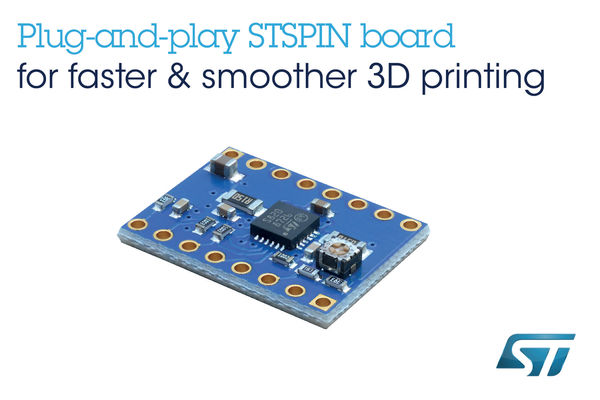
High-Speed, High-Resolution Motor-Driver Board from STMicroelectronics Maximizes Open-Source 3D-Printer Performance
"STMicroelectronics’ EVALSP820-XS motor-driver board brings ST’s industrial-control expertise to the RAMPS (RepRap Arduino Mega Pololu Shield) open-source 3D-printer platform, enabling 3D printer makers to unleash the full potential of their machines for faster printing and smoother surface finish. High-Speed, High-Resolution Motor-Driver Board from STMicroelectronics Maximizes Open-Source 3D-Printer Performance The RAMPS modular platform is making Fused Filament Fabrication (FFF) 3D printing accessible to makers, small businesses, and home users, for fast prototyping, making replacement parts, or education. The Arduino Mega 2560, or Arduino DUE, baseboard provides basic control, ready for users to plug-in their own choice of motor driver, extruder controller, and any other desired functions using Mega-compatible expansion shields. As a plug-and-play expansion board, ST’s EVALSP820-XS can drive RAMPS printers at an unprecedented speed for greatly increased throughput ensuring superior smoothness with microstepping resolution from ½-step to 1/256-step per microstep. Key to this giant leap in 3D-printing performance is ST’s STSPIN820 stepper-driver IC. The STSPIN820 embeds high-speed motor-control input circuitry and algorithms developed for industrial applications." [...]

AI becomes anchor of Nanning TV
"A 1.21-meter tall, 29 kg white robot will become a TV anchor of Nanning, capital of southwest China's Guangxi Zhuang Autonomous Region, Nanning TV said. The robot named "Chao Neng Xiao Bai" will host a new media program, interacting with another anchor to search for and analyse data. "Chao Neng Xiao Bai" can perform for eight to 12 hours on a single four-hour charge. It can talk and dance with people. The first show will be broadcasted on June 6 on the news channel of Nanning TV and Nanning News APP. " [...]
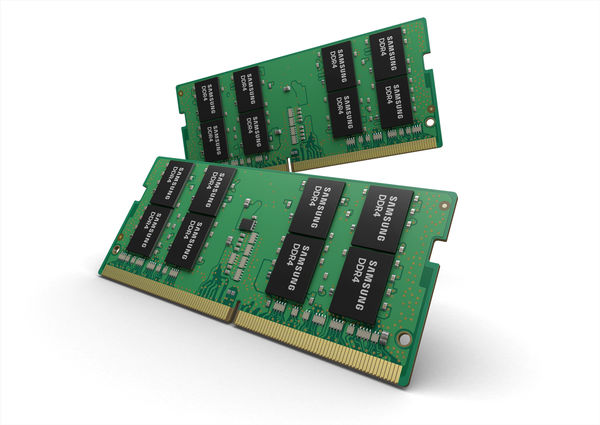
Samsung Enables More Appealing Gaming Experience with Introduction of 10nm-Class 32GB DDR4 SoDIMMs
"The new 32GB DDR4 SoDIMM doubles capacity and increases speed to 2,666Mbps with the reduction in power consumption of up to 39 percent Samsung Electronics, the world leader in advanced memory technology, today announced that it has started mass producing the industry’s first 32-gigabyte (GB) double data rate 4 (DDR4) memory for gaming laptops in the widely used format of small outline dual in-line memory modules (SoDIMMs). The new SoDIMMs are based on 10-nanometer (nm)-class process technology that will allow users to enjoy enriched PC-grade computer games on the go, with significantly more capacity, higher speeds, and lower energy consumption. Using the new memory solution, PC manufacturers can build faster top-of-the-line gaming-oriented laptops with longer battery life at capacities exceeding conventional mobile workstations, while maintaining existing PC configurations. “Samsung’s 32GB DDR4 DRAM modules will deliver gaming experiences on laptops more powerful and immersive than ever before,” said Sewon Chun, senior vice president of memory marketing at Samsung Electronics. “We will continue to provide the most advanced DRAM portfolios with enhanced speed and capacity for all key market segments including premium laptops and desktops.” Compared to Samsung’s 16GB SoDIMM based on 20nm-class 8-gigabit (Gb) DDR4, which was introduced in 2014, the new 32GB module doubles the capacity while being 11 percent faster and approximately 39 percent more energy efficient. With a total of 16 of Samsung’s newest 16-gigabit (Gb) DDR4 DRAM chips (eight chips each mounted on the front and back), the 32GB SoDIMM allows gaming laptops to reach speeds up to 2,666 megabits-per-second (Mbps)." [...]

Toshiba's Arm Cortex M Core-based Microcontrollers Support Mbed OS
"Toshiba Electronic Devices & Storage Corporation (“Toshiba”), as a Silicon Partner of Mbed (a device management solution for IoT platforms developed by Arm Ltd), acquired the certification of Mbed OS for its microcontrollers. Two evaluation boards that integrate these microcontrollers have been released on the Arm Mbed site. Mbed provides developers with a free, easy-to-use development environment. The online compiler provided by Arm can be used with evaluation boards supporting Mbed OS, and device programming can be performed with drag-and-drop simplicity on a host PC connected to the boards via USB. Developers can also access the rich component libraries verified by the Mbed community, allowing fast and efficient development of applications for embedded devices. The Arm Mbed Device Connector service provides connectivity with the Mbed Cloud, facilitating easy configuration of web services." [...]

Man Teleports Into Miniature Vehicle in Stunning On-Stage Demo at GTC Taiwan
"NVIDIA CEO Jensen Huang just used VR to shrink one of our colleagues and teleport him into a miniature car, which he then drove around a miniature city. The on-stage demonstration Wednesday was a rousing finale to Huang’s keynote at our GPU Technology Conference in Taiwan. With such technology, humans will be able to use VR to become backups for AI machines, Huang explained. Wherever these machines are. Whatever their size. “In the future you will be able to merge with the robot,” Huang told a stunned audience of more than 2,000 developers, researchers, government officials and media in Taipei." [...]
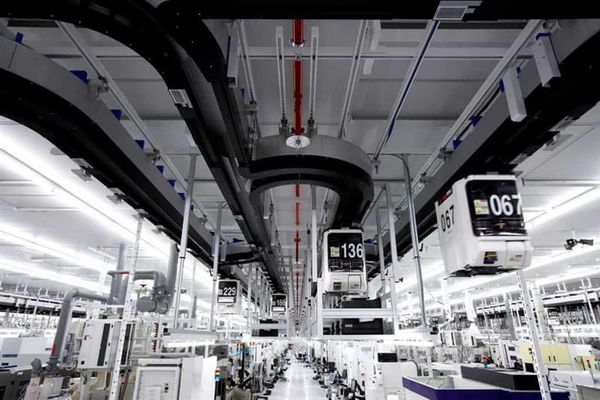
GLOBALFOUNDRIES Enters Volume Production of Ultra High Voltage Process Technology for Industrial and Power Applications
"Company’s versatile high voltage technology offers full complement of logic, analog and power devices GLOBALFOUNDRIES today announced that its 180nm Ultra High Voltage (180UHV) technology platform has entered volume production for a range of client applications, including AC-DC controllers for industrial power supplies, wireless charging, solid state and LED lighting, as well as AC adapters for consumer electronics and smartphones. The increasing demand for highly cost-effective systems requires integrated circuits (ICs) that achieve significant area savings while reducing bill-of-materials (BOM) and printed circuit board (PCB) footprint by integrating discrete components onto the same die. GF’s 180UHV platform features a 3.3V LV CMOS baseline, with options for HV18, HV30 and 700V UHV, that delivers significant area savings for both digital and analog circuit blocks, compared to the traditional 5V bipolar CMOS DMOS (BCD) technologies. “GF’s leadership in providing high voltage solutions makes the company a perfect strategic partner for On-Bright’s power supply technologies,” said Julian Chen, CEO of On-Bright, the leading market player in AC-DC switch mode power supply products. “GF’s new 180UHV process integrates UHV components into the same IC with 180nm digital and analog by incorporating On-Bright know-how in the design. The technology has reduced On-Bright’s switched-mode power supply cost and footprint to give our AC-DC switch mode power supply products additional system-level benefits.” As part of a modular platform based on the company’s 180nm process node, GF’s 180UHV process technology delivers a 10x increase in digital density compared to previous generations for integrated AC-DC conversion." [...]

For Small Screens to Large: Introducing a New Suite of IP for Premium Mobile Experiences
"News Highlights: Arm Cortex-A76 CPU: New microarchitecture enabling 35 percent more performance year-over-year for increased productivity Arm Mali-G76 GPU: Untethered gaming and on-device machine learning (ML) with 30 percent higher efficiency and performance over previous generations Arm Mali-V76 VPU: Enabling UHD 8K viewing experiences across more devices Over the last five years, we’ve seen CPU performance on smartphones increase an average of 20+ percent every year without compromising battery life. However, the same cannot be said for laptops, which have struggled to adapt to a slowing Moore’s Law over the last few years, delivering annual performance gains averaging only single-digit percentages while failing to enable any significant increases in battery life. This cadence of significant smartphone performance efficiency increases enabled by Arm did not go unnoticed by the Windows laptop ecosystem which now have integrated Arm-based SoCs from Qualcomm into their initial Always-Connected PC offerings. These Arm-based laptops are already paying off with an unprecedented 20-plus hours of battery life and steadily improving performance thanks to ongoing OS and application optimizations. Yet, the first-generation of Arm-based laptops are just the first step in the aforementioned annual performance cadence for those devices. Today Arm is announcing a new premium client solution suite of Arm computing and multimedia IP that not only provides more opportunities for smartphone innovation, but makes any gap in laptop performance a non-issue with a CPU design that delivers a staggering increase in year-over-year performance." [...]

Dawn Mission: New Orbit, New Opportunities
"NASA's Dawn spacecraft is maneuvering to its lowest-ever orbit for a close-up examination of the inner solar system's only dwarf planet. In early June, Dawn will reach its new, final orbit above Ceres. Soon after, it will begin collecting images and other science data from an unprecedented vantage point. This orbit will be less than 30 miles (50 kilometers) above the surface of Ceres -- 10 times closer than the spacecraft has ever been. Dawn will collect gamma ray and neutron spectra, which help scientists understand variations in the chemical makeup of Ceres' uppermost layer. That very low orbit also will garner some of Dawn's closest images yet." [...]
Ciência e Tecnologia
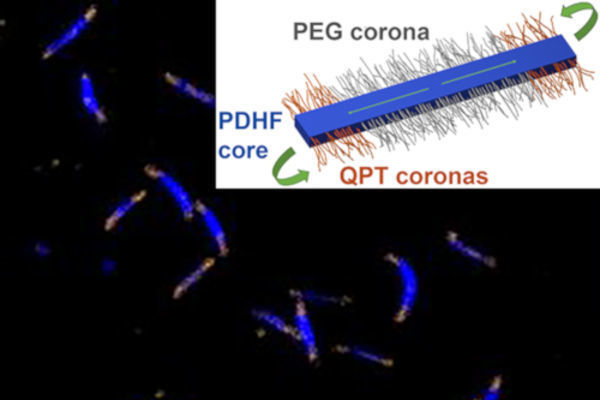
Polymer crystals hold key to record-breaking energy transport
"Scientists from the universities of Bristol and Cambridge have found a way to create polymeric semiconductor nanostructures that absorb light and transport its energy further than previously observed. This could pave the way for more flexible and more efficient solar cells and photodetectors. The researchers, whose work appears in the journal Science, say their findings could be a “game changer” by allowing the energy from sunlight absorbed in these materials to be captured and used more efficiently. Lightweight semiconducting plastics are now widely used in mass market electronic displays such those found in phones, tablets and flat screen televisions. However, using these materials to convert sunlight into electricity, to make solar cells, is far more complex. The photo-excited states – which is when photons of light are absorbed by the semiconducting material – need to move so that they can be “harvested” before they lose their energy in less useful ways." [...]
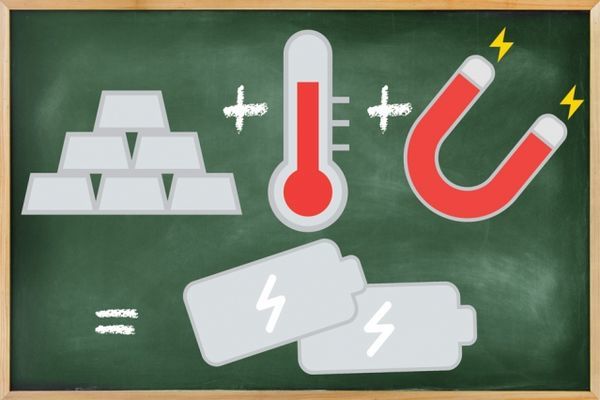
Turning up the heat on thermoelectrics
"New materials, heated under high magnetic fields, could produce record levels of energy, model shows. Imagine being able to power your car partly from the heat that its engine gives off. Or what if you could get a portion of your home’s electricity from the heat that a power plant emits? Such energy-efficient scenarios may one day be possible with improvements in thermoelectric materials — which spontaneously produce electricity when one side of the material is heated. Over the last 60 years or so, scientists have studied a number of materials to characterize their thermoelectric potential, or the efficiency with which they convert heat to power. But to date, most of these materials have yielded efficiencies that are too low for any widespread practical use." [...]

Rare element to provide better material for high-speed electronics
"Purdue researchers have discovered a new two-dimensional material, derived from the rare element tellurium, to make transistors that carry a current better throughout a computer chip. The discovery adds to a list of extremely thin, two-dimensional materials that engineers have tried to use for improving the operation speed of a chip’s transistors, which then allows information to be processed faster in electronic devices, such as phones and computers, and defense technologies like infrared sensors. Other two-dimensional materials, such as graphene, black phosphorus and silicene, have lacked either stability at room temperature or the feasible production approaches required to nanomanufacture effective transistors for higher speed devices. “All transistors need to send a large current, which translates to high-speed electronics,” said Peide Ye, Purdue’s Richard J. and Mary Jo Schwartz Professor of Electrical and Computer Engineering. “One-dimensional wires that currently make up transistors have very small cross sections. But a two-dimensional material, acting like a sheet, can send a current over a wider surface area.” Tellurene, a two-dimensional film researchers found in the element tellurium, achieves a stable, sheet-like transistor structure with faster-moving “carriers” – meaning electrons and the holes they leave in their place." [...]

Supertetrahedra Lego for future batteries
"New sodium-based all-solid-state batteries could enable future energy storage devices using only the easy-to-access, cheap and earth abundant elements sodium, silicon and phosphorous (Na, Si and P). By shaping them into sodium phosphidosilicates containing large supertetrahedral entities, NIM scientist Prof. Bettina Lotsch and colleagues generated solid electrolytes with very high ionic conductivity. Solid sodium ion conductors, based on the earth abundant and relatively cheap elements Na, Si and P, can be composed into sodium phosphidosilicates. These provide an intriguing structure composed of phosphidosilicate supertetrahedra surrounded by sodium ions. Professor Opens external link in new windowBettina Lotsch and colleagues analyzed six new phosphidosilicate structures and could show that with increasing size of the supertetrahedra, the conductivity of the structure also increased. The highest ionic conductivity was detected for the T5/T5-type supertetrahedral cluster." [...]
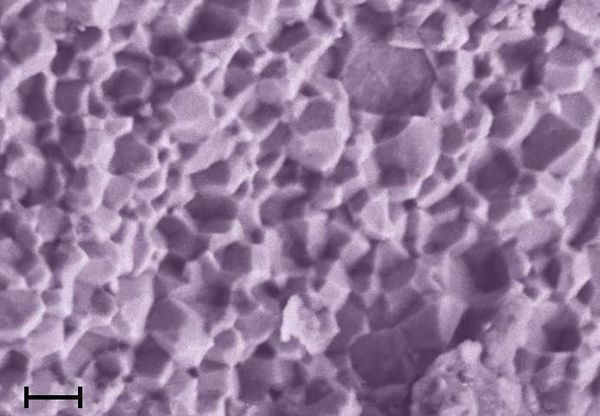
A Better Way to Control Crystal Vibrations
"By introducing impurities to a material, researchers can control the speed and frequency of phonons, potentially leading to more energy-efficient devices. The vibrational motion of an atom in a crystal propagates to neighboring atoms, which leads to wavelike propagation of the vibrations throughout the crystal. The way in which these natural vibrations travel through the crystalline structure determine fundamental properties of the material. For example, these vibrations determine how well heat and electrons can traverse the material, and how the material interacts with light. Now, researchers have shown that by swapping out just a small fraction of a material's atoms with atoms of a different element, they can control the speed and frequencies of these vibrations. This demonstration, published in Applied Physics Letters, by AIP Publishing, provides a potentially simpler and cheaper way to tune a material's properties, allowing for a wide range of new and more efficient devices, such as in solid-state lighting and electronics." [...]
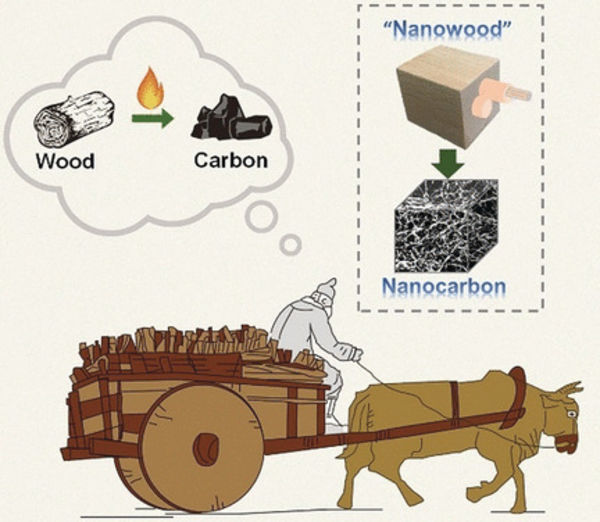
Wood to Supercapacitors
"Sustainable highly conductive electrode materials from ultrathin carbon nanofiber aerogels derived from nanofibrillated cellulose Carbon aerogels are ultralight, conductive materials, which are extensively investigated for applications in supercapacitor electrodes in electrical cars and cell phones. Chinese scientists have now found a way to make these electrodes sustainably. The aerogels can be obtained directly from cellulose nanofibrils, the abundant cell-wall material in wood, finds the study reported in the journal Angewandte Chemie. Supercapacitors are capacitors that can take up and release a very large amount of energy in a very short time. Key requirements for supercapacitor electrodes are a large surface area and conductivity, combined with a simple production method. Another growing issue in supercapacitor production—mainly for smartphone and electric car technologies—is sustainability." [...]

Researchers to Develop Self-Evaluating Robots
"Robots can do a lot of things – assemble cars, search for bombs, cook a meal or assist in surgery. But something they can’t do is tell you how they are doing. Researchers from UMass Lowell and several other universities are aiming to change that. With funding from the U.S. Department of Defense’s Multidisciplinary University Research Initiative (MURI), robotics experts from Carnegie Mellon University, UML, Brigham Young University and Tufts University are working together to give humanoid robots and other autonomous systems the ability to assess themselves in terms of how well they can perform a given task or why they cannot complete the job. This real-time feedback is vital as robots become increasingly autonomous and are tasked with jobs in remote, hostile or dynamic environments with minimal human supervision or intervention. The project – called SUCCESS, which stands for Self-assessment and Understanding of Competence and Conditions to Ensure System Success – is one of 24 grants awarded nationwide this year through the highly competitive MURI program." [...]
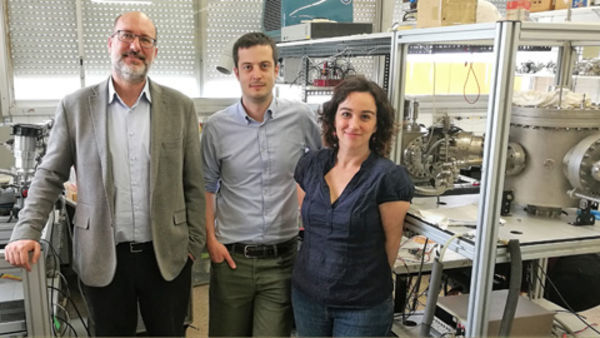
Organic light-emitting diodes become brighter and more durable
"Organic light-emitting diodes (OLEDs) truly have matured enough to allow for first commercial products in form of small and large displays. In order to compete in further markets and even open new possibilities (automotive lighting, head-mounted-displays, micro displays, etc. ), OLEDs need to see further improvements in device lifetime while operating at their best possible efficiency. Currently, intrinsic performance progress is solely driven by material development. Now researchers from the Universitat Autònoma de Barcelona and Technische Universität Dresden demonstrate the possibility of using ultrastable film formation to improve the performance of state-of-the-art OLEDs. In their joint paper published in Science Advances with the title ‘High-performance organic light-emitting diodes comprising ultrastable glass layers’, the researchers show in a detailed study significant increases of efficiency and operational stability (> 15% for both parameters and all cases, significantly higher for individual samples) are achieved for four different phosphorescent emitters." [...]

Ingestible "bacteria on a chip" could help diagnose disease
"Ultra-low-power sensors carrying genetically engineered bacteria can detect gastric bleeding. MIT researchers have built an ingestible sensor equipped with genetically engineered bacteria that can diagnose bleeding in the stomach or other gastrointestinal problems. This “bacteria-on-a-chip” approach combines sensors made from living cells with ultra-low-power electronics that convert the bacterial response into a wireless signal that can be read by a smartphone. “By combining engineered biological sensors together with low-power wireless electronics, we can detect biological signals in the body and in near real-time, enabling new diagnostic capabilities for human health applications,” says Timothy Lu, an MIT associate professor of electrical engineering and computer science and of biological engineering. In the new study, appearing in the May 24 online edition of Science, the researchers created sensors that respond to heme, a component of blood, and showed that they work in pigs. They also designed sensors that can respond to a molecule that is a marker of inflammation." [...]
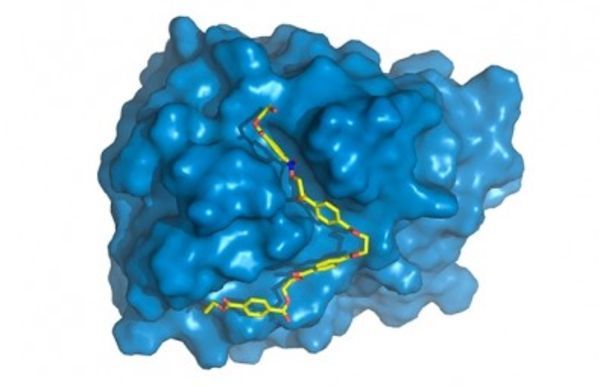
Research enhances enzyme that degrades plastic
"Between 4.8 billion and 12.7 billion kilograms of plastic are dumped in the oceans every year, and if this trend continues, the volume will increase tenfold by 2025, according to a study based on data for 2010 and published in the journal Science in 2015. One of the properties of plastic that explains why it is so widely used is also the main reason it is so harmful to the environment: its resistance to degradation. Bottles and other objects made of PET (polyethylene terephthalate) take at least 800 years to biodegrade in landfills or the sea. In this context, it is easy to understand the strong interest aroused by the discovery of an enzyme that can digest PET. Now, that enzyme, known as PETase, has had its capacity to break down plastic boosted. The innovation is described in an article published in Proceedings of the National Academy of Sciences of the United States of America (PNAS)." [...]
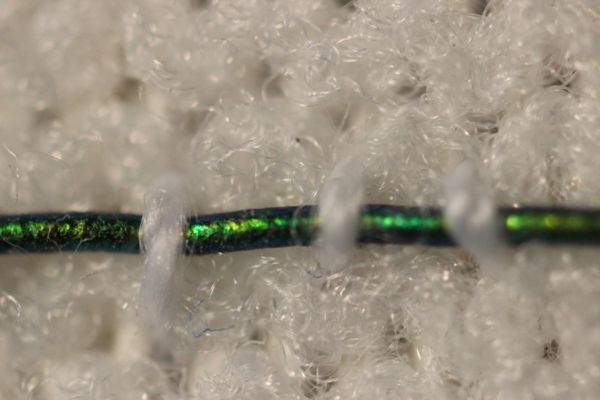
Engineers design color-changing compression bandage
"Compression therapy is a standard form of treatment for patients who suffer from venous ulcers and other conditions in which veins struggle to return blood from the lower extremities. Compression stockings and bandages, wrapped tightly around the affected limb, can help to stimulate blood flow. But there is currently no clear way to gauge whether a bandage is applying an optimal pressure for a given condition. Now engineers at MIT have developed pressure-sensing photonic fibers that they have woven into a typical compression bandage. As the bandage is stretched, the fibers change color. Using a color chart, a caregiver can stretch a bandage until it matches the color for a desired pressure, before, say, wrapping it around a patient’s leg." [...]

New 3D printing technique enables faster, better, and cheaper models of patient-specific medical data for research and diagnosis
"What if you could hold a physical model of your own brain in your hands, accurate down to its every unique fold? That’s just a normal part of life for Steven Keating, Ph.D., who had a baseball-sized tumor removed from his brain at age 26 while he was a graduate student in the MIT Media Lab’s Mediated Matter group. Curious to see what his brain actually looked like before the tumor was removed, and with the goal of better understanding his diagnosis and treatment options, Keating collected his medical data and began 3D printing his MRI and CT scans, but was frustrated that existing methods were prohibitively time-intensive, cumbersome, and failed to accurately reveal important features of interest. Keating reached out to some of his group’s collaborators, including members of the Wyss Institute at Harvard University, who were exploring a new method for 3D printing biological samples. “It never occurred to us to use this approach for human anatomy until Steve came to us and said, ‘Guys, here’s my data, what can we do?” says Ahmed Hosny, who was a Research Fellow with at the Wyss Institute at the time and is now a machine learning engineer at the Dana-Farber Cancer Institute. The result of that impromptu collaboration – which grew to involve James Weaver, Ph.D., Senior Research Scientist at the Wyss Institute; Neri Oxman, Ph.D., Director of the MIT Media Lab’s Mediated Matter group and Associate Professor of Media Arts and Sciences; and a team of researchers and physicians at several other academic and medical centers in the US and Germany – is a new technique that allows images from MRI, CT, and other medical scans to be easily and quickly converted into physical models with unprecedented detail." [...]
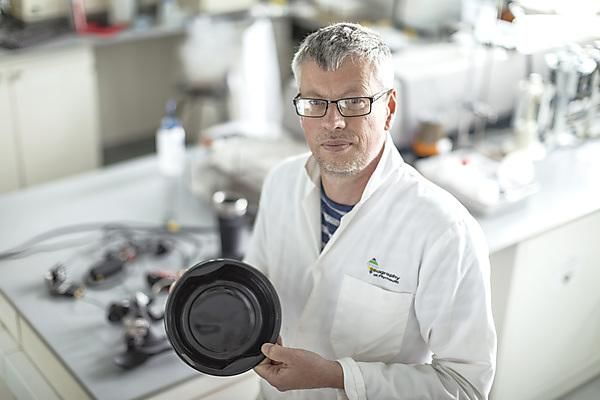
Recycled electrical products lead to hazardous chemicals appearing in everyday items
"Hazardous chemicals such as bromine, antimony and lead are finding their way into food-contact items and other everyday products because manufacturers are using recycled electrical equipment as a source of black plastic, according to a new study. The substances are among those applied to devices, such as laptops and music systems, as flame retardants and pigments but remain within the products when they reach the end of their useful lives. Now scientists at the University of Plymouth have shown that a combination of the growing demand for black plastic and the inefficient sorting of end-of-life electrical equipment is causing contaminated material to be introduced into the recyclate. This is in part because despite black plastics constituting about 15 per cent of the domestic waste stream, this waste material is not readily recycled owing to the low sensitivity of black pigments to near infrared radiation used in conventional plastic sorting facilities. The study is published in Environmental International and was conducted by Dr Andrew Turner, a Reader in Environmental Science at the University. As well as posing a threat to human health, he says the study demonstrates there are potentially harmful effects for the marine and coastal environment either through the spread of the products as litter or as microplastics." [...]
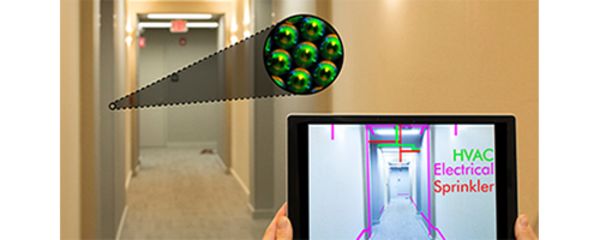
Researchers explore new applications for "Smart" Material
"Research led by scientists from the University of Luxembourg has shown the potential of liquid crystal shells as enabling material for a vast array of future applications, ranging from autonomous driving to anti-counterfeiting technology and a new class of sensors. Liquid Crystals, already widely used in flat-screen TVs, are materials that are in a state between solid and liquid. Prof. Jan Lagerwall and his team at the Physics and Materials Science Research Unit (PHYMS) at the University of Luxembourg have been investigating the unique mechanical and optical properties of microscopic shells that are produced of liquid crystal for several years. Now, in a multidisciplinary collaboration with IT scientists Dr Gabriele Lenzini and Prof. Peter Ryan of the University’s Interdisciplinary Center for Security and Trust (SnT) as well as Mathew Schwartz, Assistant Professor at the New Jersey Institute of Technology, they published a report in the scientific journal Advanced Materials describing potentially groundbreaking future applications for the material. Guiding autonomous vehicles Liquid Crystal shells, only fractions of a millimeter in size so they can easily be applied to surfaces, have several unique properties that could be utilised in engineering: As they reflect light highly selectively, they can be arranged into patterns that are readable for machines, akin to a QR code, adding coded information to objects. “These patterns could be used to guide autonomous vehicles or to instruct robots when handling workpieces in a factory." [...]

Flexible and dynamic transport solution for future 5G communications developed
"A consortium of twenty industry-leading companies and organizations has announced the successful completion of the European research project 5G-Crosshaul, coordinated by Universidad Carlos III de Madrid (UC3M). The three-year effort has delivered what is now the de-facto concept for an integrated 5G transport network, a crucial step towards the real-world implementation of the future 5G communications system. The 5G-Crosshaul consortium was selected in 2015 to develop a 5G transport network that would integrate backhaul and fronthaul, two typical segments of the 4G telecommunications networks. On the fifth generation of communication networks that is expected to replace 4G around 2020, these two segments merge into what is known as crosshaul to enable a flexible and software-defined reconfiguration of all networking elements in a multi-tenant, service-oriented and unified management environment. The transport network now presented flexibly interconnects distributed 5G radio access and core network functions hosted on in-network cloud nodes. This configuration is achieved through the implementation of a control infrastructure coupled with a unified data plane, encompassing innovative high-capacity transmission technologies as well as novel deterministic-latency switch architectures." [...]

Building Nanomaterials for Next-Generation Computing
"Scientists recently developed a blueprint to fabricate new nanoheterostructures using 2-D materials. Nanoscientists at Northwestern University have developed a blueprint to fabricate new heterostructures from different types of 2-D materials. 2-D materials are single atom layers that can be stacked together like “nano-interlocking building blocks.” Materials scientists and physicists are excited about the properties of 2-D materials and their potential applications. The researchers describe their blueprint in the Journal of Applied Physics, from AIP Publishing. “We’ve outlined an easy, deterministic and readily deployable way to stack and stitch these individual layers into orders not seen in nature,” said Jeffrey Cain, an author on the paper who was formerly at Northwestern University but is now at Lawrence Berkeley National Laboratory and the University of California. Cain explained that for nanoscientists, “the dream” is to combine 2-D materials in any order and collate a library of these heterostructures with their documented properties." [...]

First 3D printed human corneas
"The first human corneas have been 3D printed by scientists at Newcastle University. It means the technique could be used in the future to ensure an unlimited supply of corneas. As the outermost layer of the human eye, the cornea has an important role in focusing vision. Yet there is a significant shortage of corneas available to transplant, with 10 million people worldwide requiring surgery to prevent corneal blindness as a result of diseases such as trachoma, an infectious eye disorder. In addition, almost 5 million people suffer total blindness due to corneal scarring caused by burns, lacerations, abrasion or disease. The proof-of-concept research, published today in Experimental Eye Research, reports how stem cells (human corneal stromal cells) from a healthy donor cornea were mixed together with alginate and collagen to create a solution that could be printed, a ‘bio-ink’." [...]

Cometh the cyborg: improved integration of living muscles into robots
"The new field of biohybrid robotics involves the use of living tissue within robots, rather than just metal and plastic. Muscle is one potential key component of such robots, providing the driving force for movement and function. However, in efforts to integrate living muscle into these machines, there have been problems with the force these muscles can exert and the amount of time before they start to shrink and lose their function. Now, in a study reported in the journal Science Robotics, researchers at The University of Tokyo Institute of Industrial Science have overcome these problems by developing a new method that progresses from individual muscle precursor cells, to muscle-cell-filled sheets, and then to fully functioning skeletal muscle tissues. They incorporated these muscles into a biohybrid robot as antagonistic pairs mimicking those in the body to achieve remarkable robot movement and continued muscle function for over a week. The team first constructed a robot skeleton on which to install the pair of functioning muscles." [...]

Novel Power Meter Opens the Door for In-Situ, Real-Time Monitoring of High-Power Lasers
"NIST researchers have developed a compact, high-accuracy, point-of-use high-power laser power meter in the form of a folding mirror called “Smart Mirror,” making in-situ, real-time measurement of laser power possible Orlando, FL – High-power lasers are now widely used in additive manufacturing and laser welding systems to precisely cut and weld metal, making all kinds of metal parts for medical devices, aerospace applications, automotive industries, and more. With the rise in industrial use of high-power laser processing, manufacturers increasingly seek high-accuracy, point-of-use laser power meters that can quickly report laser powers at any time in the manufacturing process -- a vital aspect to controlling product quality. Traditional laser power meters, however, are often bulky in size and slow in response time. Power measurements can also only be taken separately, interrupting the manufacturing process. Now, a group of researchers from National Institute of Standards and Technology (NIST) in Boulder, Colorado, have developed a smaller, faster and more sensitive laser power meter in the form of a folding mirror they call a “smart mirror.” The novel design uses a capacitor-based force transducer and merges optical elements, namely a high reflectivity mirror, and sensing elements into a compact cube package. The four-centimeter-on-a-side cubes can be conveniently embedded into laser optical systems or laser-welding systems for point-of-use, real-time laser power measurement and calibration." [...]
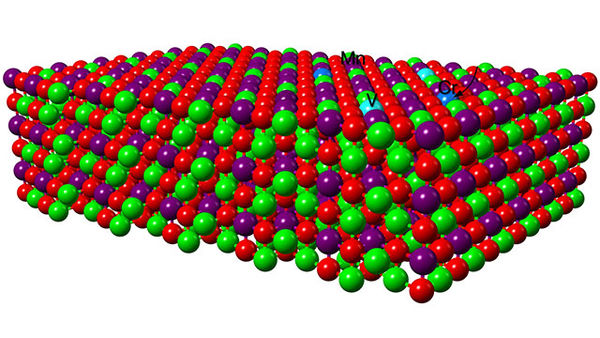
Northwestern researchers predict materials to stabilize record-high capacity lithium-ion battery
"Advancement could pave the way for less expensive, longer-lasting batteries for electric vehicles A Northwestern University research team has found ways to stabilize a new battery with a record-high charge capacity. Based on a lithium-manganese-oxide cathode, the breakthrough could enable smart phones and battery-powered automobiles to last more than twice as long between charges. “This battery electrode has realized one of the highest-ever reported capacities for all transition-metal-oxide-based electrodes. It’s more than double the capacity of materials currently in your cell phone or laptop,” said Christopher Wolverton, the Jerome B. Cohen Professor of Materials Science and Engineering in Northwestern’s McCormick School of Engineering, who led the study. “This sort of high capacity would represent a large advancement to the goal of lithium-ion batteries for electric vehicles.” The study was published online May 18 in Science Advances. Lithium-ion batteries work by shuttling lithium ions back and forth between the anode and the cathode." [...]

Turning up the heat on thermoelectrics
"New materials, heated under high magnetic fields, could produce record levels of energy, model shows. Imagine being able to power your car partly from the heat that its engine gives off. Or what if you could get a portion of your home’s electricity from the heat that a power plant emits? Such energy-efficient scenarios may one day be possible with improvements in thermoelectric materials — which spontaneously produce electricity when one side of the material is heated. Over the last 60 years or so, scientists have studied a number of materials to characterize their thermoelectric potential, or the efficiency with which they convert heat to power. But to date, most of these materials have yielded efficiencies that are too low for any widespread practical use." [...]
Modelos 3D
Com a disponibilidade de ferramentas que permitem dar azo a nossa imaginação na criação de peças 3D e espaços como o thingiverse para as publicar, esta rubrica apresenta alguns modelos selecionados que poderão ser úteis.
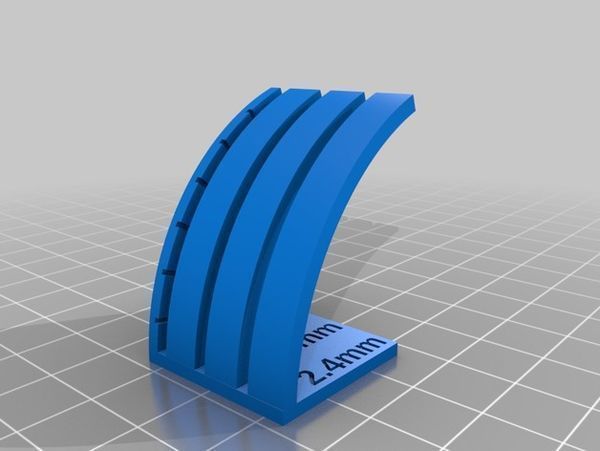
Customizable Curved Overhang Tester
"This is an attempt at an overhang tester with a little bit of a different look. See how well your printer and filament can handle overhangs of thin materials. Check both for print quality and for how well each curve lines up with the backing. I've included pictures of a 40mm version of this printed out on an Ultimaker 3 with PLA and standard Cura settings. You can see fairly typical results for this type of overhang test: a relatively serene and normal top surface, concealing the horror show that increasingly engulfs the underside as the overhang passes the magic 45-degree mark. With thin curves like this, errors are introduced from at least two sources: the usual sag of unsupported material at the edge of each layer, and the slight mismatches caused by the curves being pushed ever-so-slightly back and forth by the tip of the nozzle.Feedback is welcomed." [...]

2d_points: generate 2D shapes as arrays of points in OpenSCAD
"Generate 2D shapes as arrays of points in OpenSCAD https://github.com/sadr0b0t/2d_points also available from Openscad-Modules repo https://github.com/RobertFach/Openscad-Modules spm install 2d_points All shapes are generated as array of points, you should apply them to polygon call on your own. This might be convenient, if you want to pass some unknown beforehand shape to module or function as param. " [...]
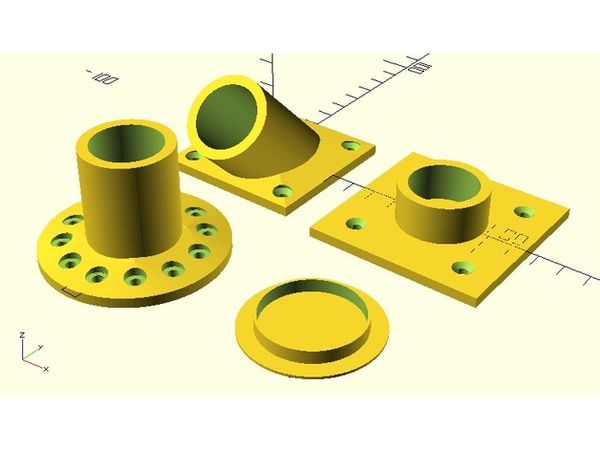
Pipe Flange Basics
"This is a basic parametric pipe flange. Some options:pipe sizepipe angle from perpendicularwall thicknesssquare or round flangequantity and style of mounting holes" [...]
Documentação
A documentação é parte essencial do processo de aprendizagem e a Internet além de artigos interessantes de explorar também tem alguma documentação em formato PDF interessante de ler. Todos os links aqui apresentados são para conteúdo disponibilizado livremente pelo editor do livro.

newelectronics de 22 de Maio 2018
"New Electronics is a fortnightly magazine focusing on technological innovation, news and the latest developments in the electronics sector. Downloadable as a digital page turner or pdf file, or offered as a hard copy, the New Electronics magazine is available in a format to suit you. " [...]
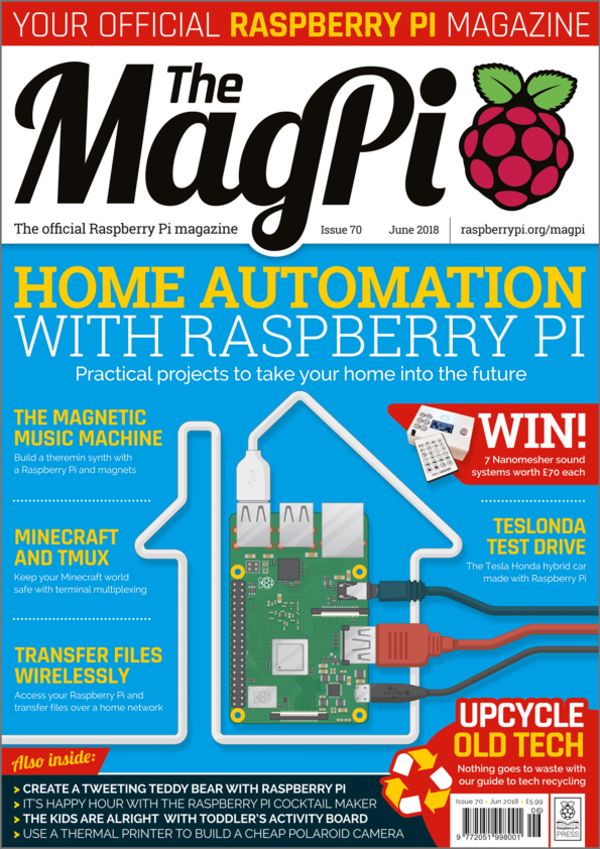
The MagPI 70
"Discover home automation; upcycle your old projects and build a tweeting teddy bear in issue 70 of The MagPi. Plus! Teslonda – the Tesla/Honda hybrid that uses Raspberry Pi for a dashboard. All this inside The MagPi 70 - Home automation with Raspberry Pi. Practical projects that take your home into the future. - Teslonda." [...]
Projetos Maker
Diversos Projetos interessantes.

Arduino Neural Network Self Balancing Two Wheel Robot
"This is a very simple application of a neural net solution for controlling a two wheeled self balancing robot. The robot does not do anything more than self balance; no control for directional control. But the project was simply to see if I could figure out how to use a neural net rather than a PID controller. Currently, I have a very primitive understanding of neural nets and I understand the basic concepts but I believe a lot more sophistication could be utilized in applying an ANN (Artificial Neural Network) to a self balancing robot. I hope there will be some comments by persons in the know about NNs with some ideas that could be applied here. I adapted Sean Hodgins neural net code and you can find more specifics on how it works on his instructable here: https://www.instructables.com/id/Arduino-Neural-Net..." [...]
Solar Tracking With Arduino - Intelligent System
"The solar tracking works on the principal of astronomical equations. With the help of the equation it calculates the coordinates of the sun by calculating the elevation and azimuth angle given the latitude, longitude and time zone of a given place. The use of a tracking system greatly improves the power gain from solar radiation. The amount of current a PV panel produces has a direct correlation with the intensity of light the panel is absorbing.For more information, click here. " [...]
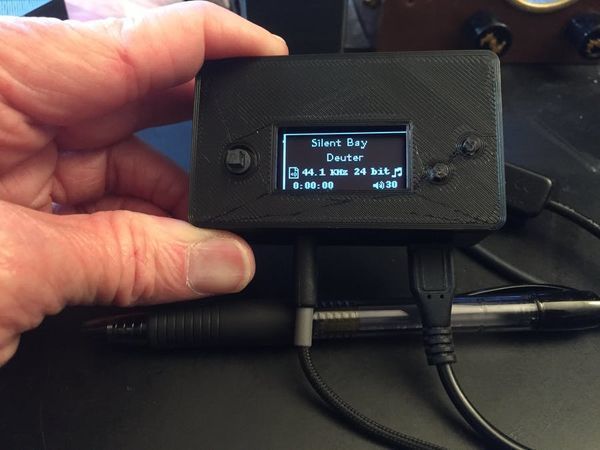
Volumio Mini Music Player
"This tiny imp does it all: on-the-go player or WiFi/AirPlay streamer, battery bank or wall power, headphones or speakers. Story While making travel plans for the year, I thought it would be really nice to have the single, smallest possible music player to take along. Something that does it all - play from NAS or all my music direct from the device; be able to play on a long flight or walking around; hook up to a powered speaker for a (semi-) stationary player. You can even play Spotify! And do AirPlay! Yep, you can do all this from a phone." [...]

Arduino I2C Sniffer
"I2C is a serial protocol used to communicate a microcontroller with external peripherals attached to the same circuit. Each peripheral must have a unique ID number called address that is used to identify it as the intended recipient of a given message. Those addresses are assigned by the device manufacturer and most of the times can not be changed. A sniffer scans all the possible addresses looking for connected devices and reports the ones it finds. This helps identify unmarked chips as then the address can tehn be googled for more information regarding the chip. This device mimics on an Arduino UNO the behavior of the Raspberry Pi i2cdetect script, sniffing all the possible i2c addresses looking for connected devices and printing the results nicely on a 16x02 LCD screen." [...]
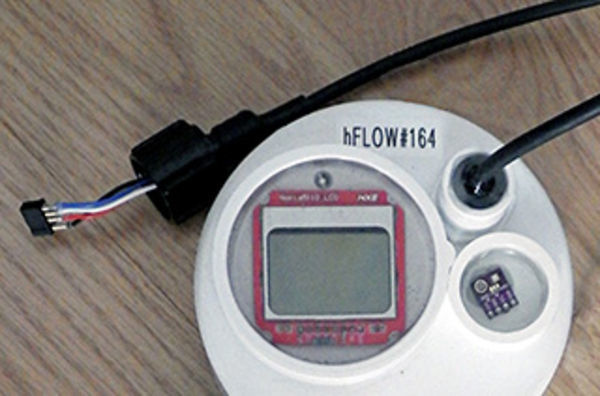
Adding the Nokia 5110 LCD to your Arduino Data Logger
"This year I want to tackle some projects that need live data out, so I’ve been sifting through the many display options available for Arduino. Unlike flashier projects, my goal was to find one that I could add to existing logger builds without sacrificing too much of the multi-year lifespan I had worked so hard to achieve. The low power winner by a fair margin was the Nokia 5110 which you can pick up for around $2 from the usual sources. With the back-light off these displays pull between 100-400 μA, depending on the number of pixels turned on. This screen uses a PCD8544 controller and the SPI protocol. It will tolerate 5V, but it works best at 3.3V, which is perfect when you are driving it from an 8mhz ProMini." [...]

Linear clock
"When the "glow in the dark" clock was finished it realized that I could relatively easily start another clock project. An idea I've had in my mind for many years... the linear clock. Now a linear clock is nothing new, but making it as simple as possible THAT is the main idea I had. So knowing how to get time from an NTP server and knowinghow to make MDF look pretty I decided it was time to start this project and really finish it as quickly as possible. Because the "glow in the dark" clock has took me over 3 years, I did not want to repeat that. So, full of motivation, having the technology and skills..." [...]
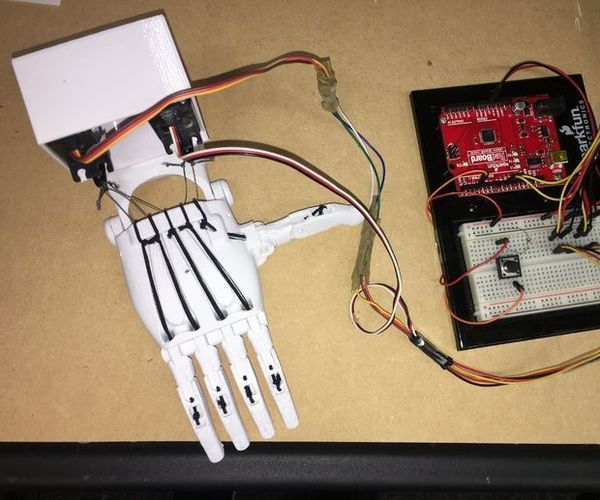
Servo Controlled Prosthetic Hand
"Hi, here I am making a prosthetic hand controlled by servos to make it grip. I am making a right hand but I included the files to print a left palm as well. The assembly is the same for both left and right hands. " [...]
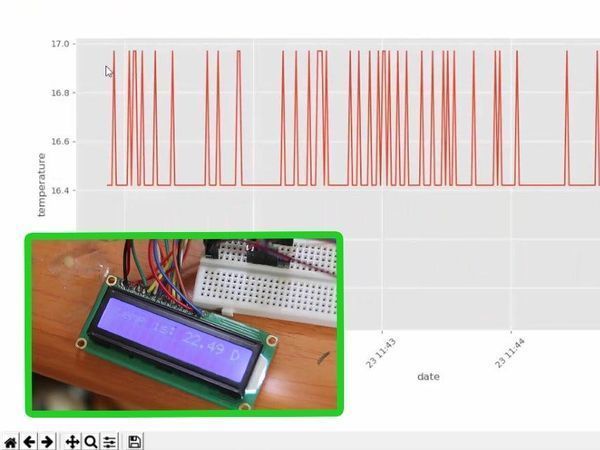
Arduino & Python3 Temperature Data Visualizer
"This is an Arduino based project using an NTC thermistor to collect temperature data and Python 3 to save and visualize it. This is a very simple project where we will use an ntc thermistor as a temperature captor an Arduino to get the value of resistance of the ntc thermistor and convert it to a valid data of temperature then send it to the computer using serial where we can keep and visualize it. Also we will use an lcd to display the temperature. " [...]
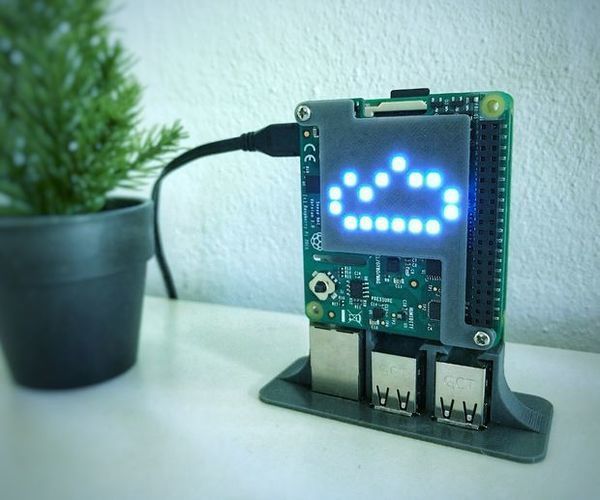
RPi Weather Station and Digital Clock
"This is a quick and easy project to make, and a nice display to show off. It displays both the time, weather condition and temperature. And please, if you like this project, vote for me in the Microcontroller Contest: https://www.instructables.com/contest/microcontroller2018/. The code is based on StuffWithKirby's useful code on reading JSON weather data in python, and SteveAmor on Github's super cool SenseHat digital clock code. You will need: A Raspberry Pi 3(Any 40-pin Raspberry Pi will work)A Raspberry Pi SenseHat(Or any other display, to display the weather data on)A 5V 2.4A Power Supply for Raspberry Pi A 8GB or higher Micro SD Card with the latest version of Raspian A 3D printer and a spools of any color PLA (Optional)" [...]
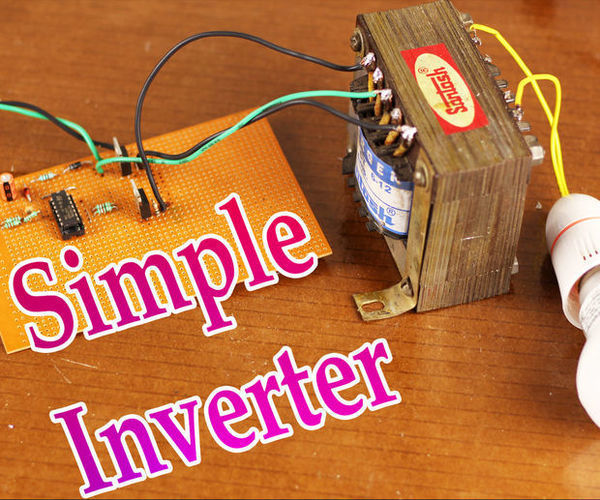
100W Inverter Circuit
"An inverter converts the DC voltage to an AC voltage. In most cases, theinput DC voltage is usually lower than the output voltage of the inverter while the output AC is equal to the grid supply voltage 120 volts, or 240 Volts. Let's make a fully functional inverter circuit. " [...]

Simple RPM Meter Using Cheap Modules
"This is a very intresting project and utlize very less efforts lts make a very simple RPM meter (Round Per Seceond In my case). " [...]

Raspberry PI: Charting Ambient vs Outside Temperature
"How to use a Raspberry PI to chart ambient temperature vs outside temperature. Source code and schematics below. What you need: Raspberry PI with an internet connection DS18B20 temperature sensor (RasPI tutorial at Adafruit) Account at sen.se to log your values Reading the graph above is pretty obvious. It plots the temperature of the DS18B20 sensor connected to the Raspberry PI vs. the outside temperature that is provided by a local weather forecast feed. Just for fun, we also display Min and Max temperatures (which can be reset). ----- The graphing is provided by sen.se." [...]

counting bees on a rasp pi with a conv net
"counting bees the first thing i thought when we setup our bee hive was "i wonder how you could count the number of bees coming and going?" after a little research i discovered it seems noone has a good non intrusive system for doing it yet. it can apparently be useful for all sorts of hive health checking. the first thing to do was collect some sample data. a raspberry pi, a standard pi camera and a solar panel is a pretty simple thing to get going and at 1 frame every 10 seconds you get 5,000+ images over a day (6am to 9pm). " [...]

3D Printed Prosthetic Hand With Capacitive Touch Sensing
"In this Instructables Ive come with an idea that can be implemented to existing 3d printed prosthetic hands. In existing electrically powered prosthesis I Couldnt find the use of capacitive touch sensing technology for the actuation of fingers. This project combines two very cool things, Arduino with Capacitive touch sensing for the actuation and remix of e-NABLE Phoenix hand design. Basically the phoenix hand is a body powered hand, What Ive done on this project is that I converted it into an electrically powered prosthesis by choosing required part design. The advantage of capacitive touch sensing is, through touch you can actuate the fingers easily. Currently this model cannot control individual fingers and more development is required in weight carrying capacity and grasping capacity." [...]
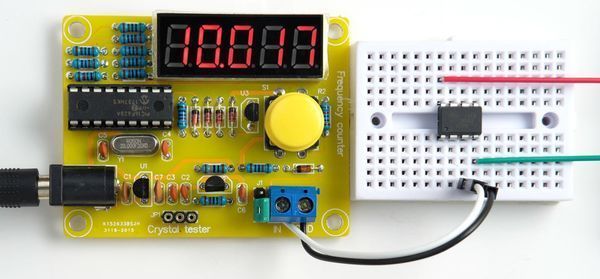
ATtiny85 20MHz Internal Clock
"The ATtiny85 is rated at a maximum clock speed of 20MHz at 4.5 – 5.5V. For some applications it would be nice to get the maximum speed without needing to buy a 20MHz crystal, or tie up two I/O lines driving the crystal. Here's how to do it. To test it I toggled an output at the clock frequency, and measured it with a frequency meter: The reading of 10MHz implies a clock frequency of 20MHz. Introduction The ATtiny85 is almost unique among the AVR chips in having an internal PLL (Phase-Locked Loop) that can multiply up the internal 8MHz clock by a factor of 8 to 64MHz, for use by Timer/Counter1. By programming a fuse you can choose to use the PLL divided by four as the system clock, giving a clock speed of 16MHz." [...]
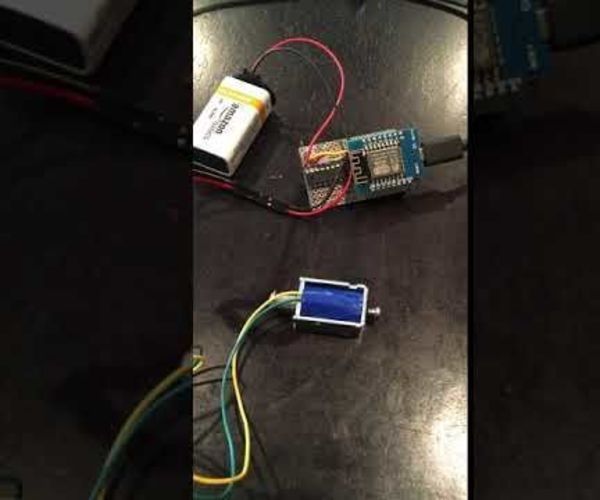
Alexa Controlled Solenoid Using WEMO D1 Mini
"It really is amazing. It's not that hard to have an alexa echo control a micro-processor. The world is your oyster. This instructable takes you through the steps to control a solenoid. You can use this same process to control whatever you want. In my case, I used the solenoid to push an elevator button." [...]
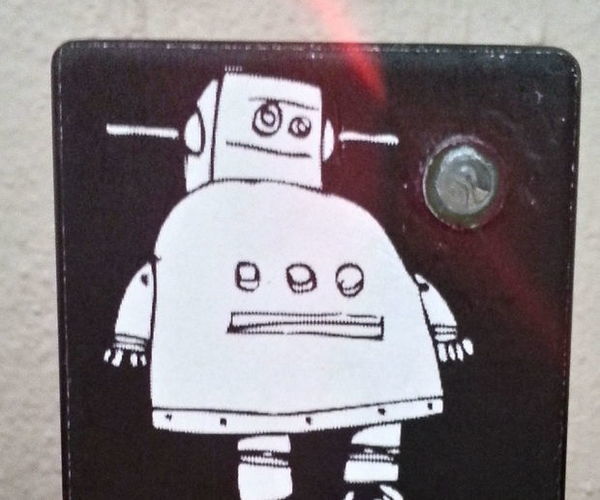
2-Year Ultra Low-Power LED Flasher
"In this Instructable, I am going to try and explain, step by step, how I designed this Ultra Low-Power LED Flasher with the following specification: LED flash rate 1 flash per second LED on-time of 5ms At least 2 years battery life Use standard "AA" size batteries Unfortunately, uses two "AA" batteries Easy obtainable components No surface mount components No PC Board To keep track of this Instructable, I will be monitoring the views using my "Instructable Hit Counter". " [...]

Iot123 - I2C Brick Prototyping Slave
"While developing the latest ASSIMILATE ACTOR (KY-019 RELAY), a generic dev board was thrown together to save me some extra work at my desk. It has the standard pinouts of the I2C IOT123 BRICK, but allows custom connections to the sensor from the ATTINY85. The ATTINY85 is removable via the DIL Socket. The I2C lines are hardwired. Everything else is breakout connectable. It works very well with the I2C BRICK MASTER JIG." [...]

Vending Machine
"We got our idea from our teacher, Mr. Hernandez. We discovered that a vending machine would be a great senior project and when complete would function as a fundraiser for our engineering program. We had a goal and a vision in place and now had to execute building a vending machine for our program. " [...]

Universal USB Keyboard With RGB Switches
"In this instructable I will show you how to build your own custom USB keyboard that behaves just like a regular computer keyboard. You can assign any key combination or sequence of keys to be pressed while pressing only one pushbutton. You can use it to optimize your computer work by assigning various key combinations to just one physical key, so it makes your life easier. You can make it a PC game controller. You can even program it to write an essay by pressing only one key :) The sky is the limit. I used it to control my CNC router manual movements, since I found using regular computer keyboard too bulky and cucumbersome to use." [...]

One Wheeled Robot
"In this project I am going to show you how to make a one wheeled or unicycle step by step so that you can make your own. This robot can balance automatically by calculating inclination with the help of MPU6050 sensor, it is consisted of two sensors gyroscope and accelerator. As only one wheel is used which is connected to gear motor so to counterbalance the robot we need to add some weight here 11.1 v lipo battery is used and this perfectly fine for balancing for left and right side, forward and backward will be controlled by wheel. The mechanical structure is made by aluminium sheet some nut and bolt every step is clearly shown in the video. " [...]
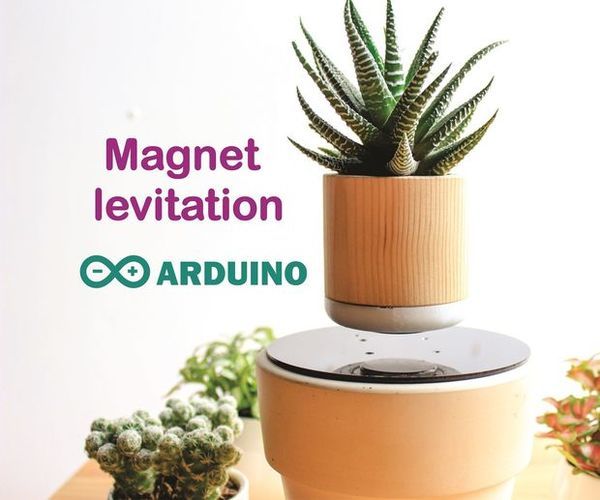
Arduino Air Bonsai Levitation
"It's been a long time since my previous tutorial, my work is quite busy and I spend less time on Instructables. This time is a project that I like very much since my first saw it on Kickstarter: Air Bonsai. I was really surprised at how the Japanese made it, really a beautiful and mysterious piece. Any mystery can be explained by looking inside, where it works. I have learn a lot about air bonsai more than a month ago and it was actually a magnetic levitation. I have also seen many tutorials on how to make magnetic leviation and all of them are making an object levitating from above where there is an electromagnet controlled by the circuit." [...]

Hanging Gear Clock
"Gears never fail to capture the interest of anyone observing them. The inspiration for this clock was a minimalist approach to a gear clock. By simply hanging an incremented gear onto a small driven gear and letting gravity and mathematics do their thing, an eye catching clock can be made. This project is aided through the use of a CNC router, however, it is possible to adapt these plans for use with other workshop equipment. All plans provided can be printed at a 1:1 scale and used as guides to help those who are not using computer assisted machining. This project also uses a micro-controller and stepper motors to make the gears move and keep time." [...]

Mini CNC Laser Wood Engraver and Paper Cutter.
"This is an Instructables on how I made an Arduino based Laser CNC wood engraver and Thin paper cutter using old DVD drives, 25mW laser. Playing area is 40mm x 400mm max. Isn't it fun making a own machine out of old things? " [...]
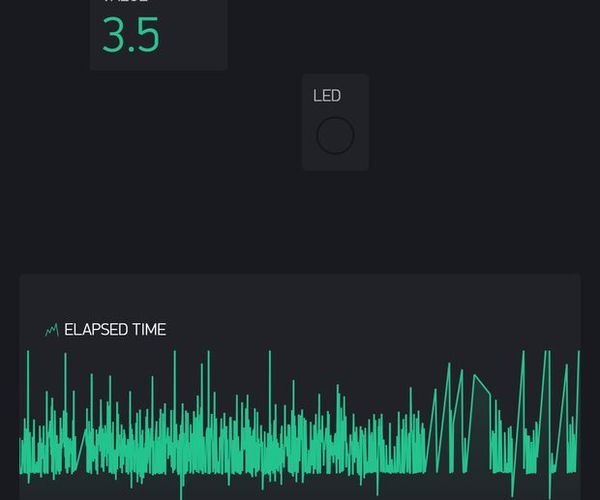
FurnaceClip
"Our furnace is a like a beast residing in our basement. When it is "on", the house has a bass hum and you can tell something is on fire, not far away from where you are. Couple this ominousness with a curiousity to know about when the furnace is coming on and for how long, and you've got the background for my FurnaceClip. (This kind of information can be useful. A few years ago, our furnace was coming on quite frequently in the summer. It didn't seem right." [...]

Led Tester
"This device will allow you to: 1. Test low power LEDs, including surface mount types, 2. Display its intrinsic voltage drop (VLED), 3. Adjust its brightness by changing the current through it (iLED), 4. Choose any voltage up to 9V that you plan to use the LED for in a project (Vtarget), and 5. Based on the above parameters, will display the proper resistance to use for that LED (RLED)." [...]
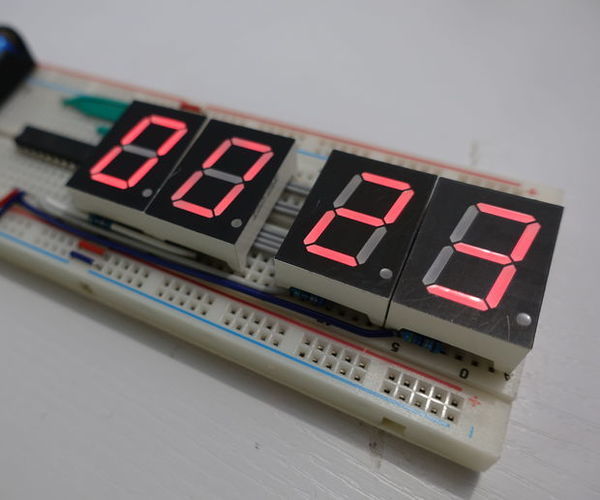
ATtiny Seven Segment Display Timer
"This instructables step by step show how to use ATtiny 8-bit Microcontroller port manipulation drive 4 seven segment display as a simple count up timer. It is a good starting point for learning how the microcontroller and seven segment display works. " [...]

Make an Illuminated Rainbow Synthesizer With an Arduino!
"This Instructable shows you how to add a high-resolution touch screen to your Arduino and make a synthesizer that controls colored LEDs! The techniques you learn here can serve as a foundation for other touch screen projects! In this Instructable, you will learn: Where to get a high resolution 800x480 touch screen. How solder a headers on the touch screen. How to 3D print and assemble an LCD stand (optional step). How to hook up the color touch screen to the Arduino Uno." [...]
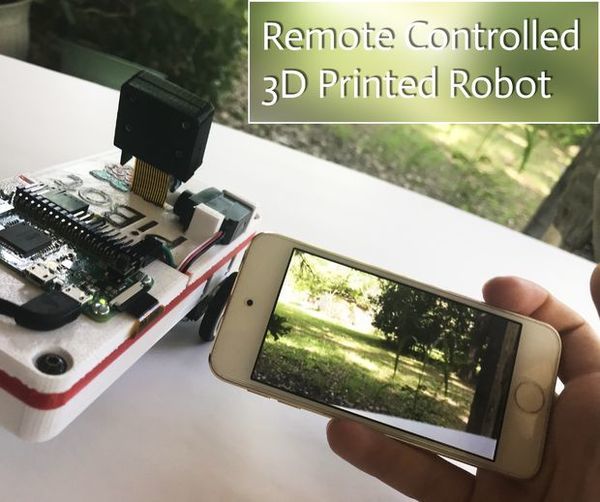
3D Printed Raspberry Pi Zero Robot
"Have you ever wanted to build a robot, but just didn't have all the materials to build one without ending up with an unnecessarily bulky chassis? 3D printers are here to save the day! Not only can they create parts to be compatible with virtually any hardware, they can do it in a very space efficient way. Here I will show you how to create a very basic robot which features 3D printed parts, the Raspberry Pi Zero, and the Pi Camera. I would encourage you to take and modify what I have done to fit your practical or entertainment needs. To control the robot and view the camera feed, I built an IOS app (the PiBotRemote app) that you can feel free to use and modify." [...]
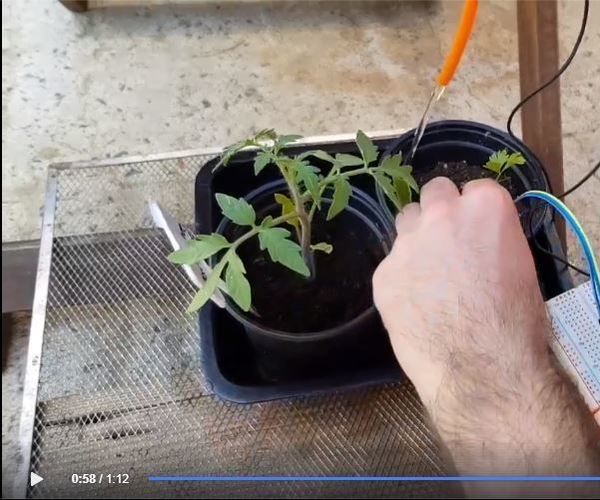
AUTOMATED WATERING SYSTEM OF a GREENHOUSE
"Hi, In this instructable, we will build an automated watering system of a greenhouse in order to save water and save time. Our friend will therefore spend much less time following the watering of his plants. " [...]

VISUINO Smart Robot Car 315mhz Remote Control Module XD-YK04
"In this tutorial we will use Smart Robot Car, L298N DC MOTOR CONTROL module, 4ch 315mhz remote control module XD-YK04, Arduino Uno and Visuino to control the robot car with a remote control. " [...]
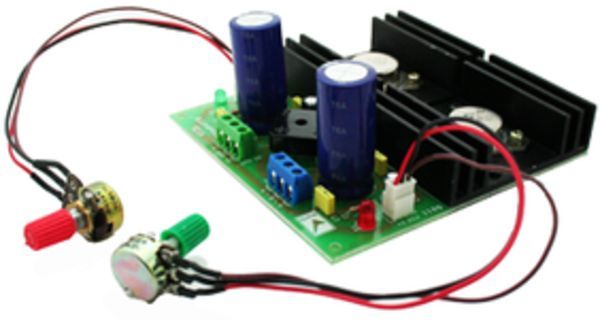
Dual Adjustable Power Supply
"This project is a solution to power up most of devices or projects requiring dual (+/-) adjustable power supply. The circuit is based on LM317 positive and LM337 negative voltage regulators. LM317 series of adjustable 3 terminal regulator is capable of supplying in excess of 1.5A over a 1.2V to 30V DC output range, due to TO3 package of IC and large heat sink the power supply can handle maximum load current. " [...]

Arduino Joystick Servo Control Using 1Sheeld
"Have you ever wondered how does robot arm work? Or even wanted to make an automated door locker? Or watched a robot that sees all its surroundings with only one sensor, and wanted to make your own? Then you have to know that all these things use servo motors to enable the device to rotate a specific part of it (ex: robot arm) at a certain degree.. this is simply the magic of servo motor “the ease of controllability”. So, we’ll give it a try here with taking servo control to a whole new level by using 1Sheeld to make Arduino Joystick Servo Control tutorial. " [...]
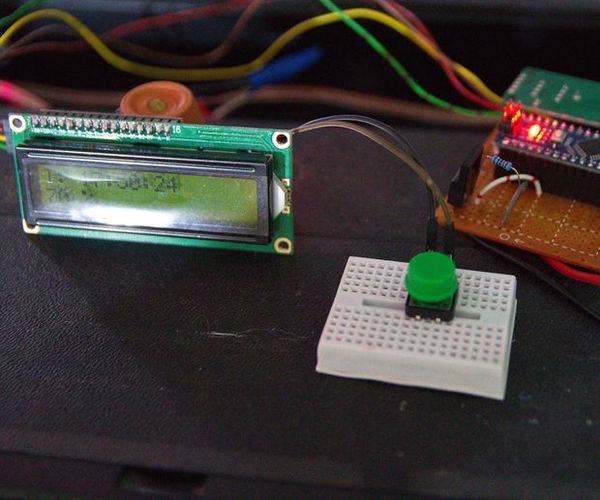
Aquarium Light PWM With Arduino
"I have recently converted my aquarium lights from fluorescent lighting to LED lighting and I have decided to try and simulate a natural environment where light gradually increase from dawn till midday and then decrease till dusk. At night there's little light usually given by the moon. Basically the LED lighting is powered from a 12V power supply and arduino controls the intensity of the light by modulating the voltage with the help of a n-channel MOSFET (I have used an IRFS630). The arduino can be powered by the same power supply but I have used a separated 5V USB PS for arduino and powered it through USB not through Vin. The light intensity might not be the most accurate but it's the best I could think of. The pattern can be modified through the code." [...]
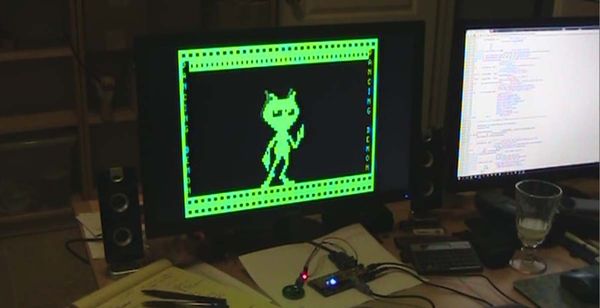
TRS-80 Model 1 on a PIC32
"TRS-80 Model I emulated on a PIC32MX processor. It provides VGA video and PS/2 keyboard so as to be usable with commonly available hardware to-date (well, PS/2 keyboards are becoming rare, but it works with a USB-to-PS/2 adapter as well). DETAILS I did this project to keep myself occupied while recovering from some surgery in 2015, for which I would have limited mobility for about a month. I didn't think I'd be up to doing bench work, so I used some existing PCBs to allow me to focus on the firmware, which I could do lying down (both literally and figuratively). I used a UBW32 (from Schmalzhaus) as a CPU 'breakout board' and also a UBW32-MCC (from Dontronics) to provide the VGA, PS/2 keyboard, SD card, and power connectors. Later, I supported another board: the Olimex Duinomite-mini (and reportedly the Duinomite with the IO board)." [...]

What is an ETA Nixie Tube Clock and How Do You Build One?
"In our house, the concept of time is somewhat fuzzy. This is especially true in the morning as we get ready for school and work. The amount of days dropping off the kids late to school is a little embarrassing. Additionally, the expenses taking the toll road so I can shave ten minutes from my commute to make the morning meetings is way out of budget. While in the car, the direction application on the smartphones can conveniently give the estimated time of arrive (ETA) to the destination, but doesn’t warn us when we should leave the house. So this hack is all about helping fix this problem and making the Nixie tube clock a little more useful than just looking cool." [...]
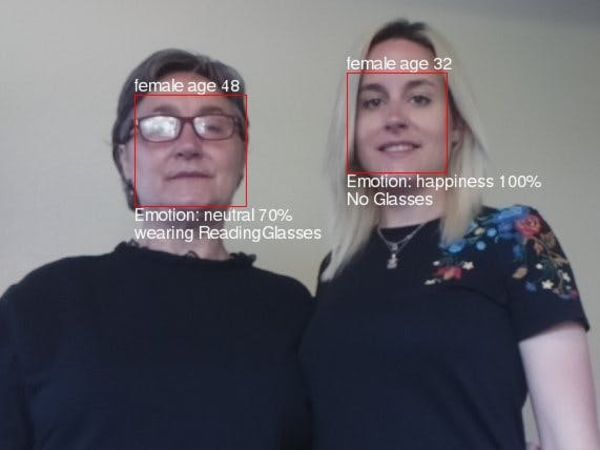
Raspberry Pi Image Recognition with Alexa Voice
"SeeTalker tells you what it sees with the help of a Raspberry Pi computer, Microsoft image recognition and Alexa Story Ask SeeTalker to tell you what it sees! The SeeTalker Alexa skill will snap a photo of what it sees and then call a Microsoft Cognitive Services API to interpret the image. Alexa gives a voice to the image recognition, telling you what it sees. SeeTalker can also take a group selfie using an Alexa command. Learning opportunities from SeeTalker: Leverage AI services at no cost (so far) Use Alexa as a voice interface Create an Alexa skill Use image recognition from Microsoft Cognitive Services Make a Raspberry Pi a web and Alexa server using Flask-Ask Send Email Use callbacks for asynchronous event handling" [...]
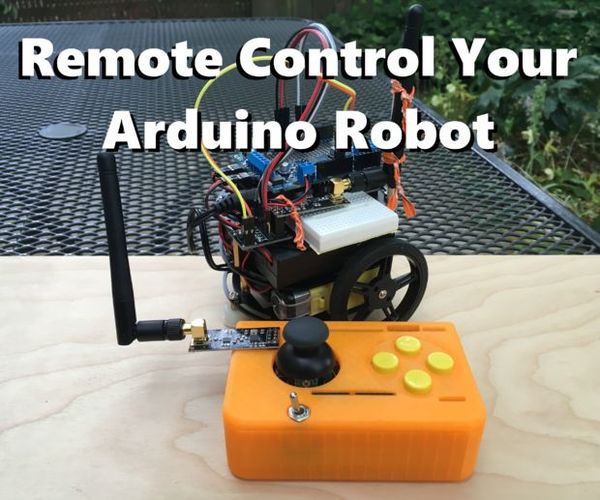
Remote Control Your Arduino Robot
"In this Instructable I am going to cover to use an Adafruit Motor Shield for Arduino V2 along side an nRF24L01 Antenna to make a long range remote controlled robot. I am using an old Adafruit Arduino 101 CurrieBot with an Arduino Uno instead of the Arduino 101 that came with the robot. This tutorial however is applicable to any Arduino project running an Adafruit Motor Shield V2 that would like to use nRF24L01 or nRF24L01+ antennas to control their project. Materials used Arduino 101 Curiebot Kit (using an Arduino Uno) - https://www.adafruit.com/product/2768Universal Arduino Controller - https://www.instructables.com/id/Universal-Arduino-Controller/2x nRF24L01 antennas - https://www.gearbest.com/transmitters-receivers-module/pp_440447.htmlnRF23L01 Breakout Adapter - https://www.addicore.com/1x-nRF24L01-Adapter-p/ad279.htmHalf a split chop stick 3x Bread Ties 7x male to female jumper wires - https://www.addicore.com/Male-Female-Jumper-Wires-40-x-200mm-7-8in-p/179.htmIf you are looking for a versatile motor controller Adafruit's motor shield is a great option. It has the capacity for four DC motors or two steppers as well as many servos. The controller accepts a separate power supply if you don't want to share with the Arduino below." [...]
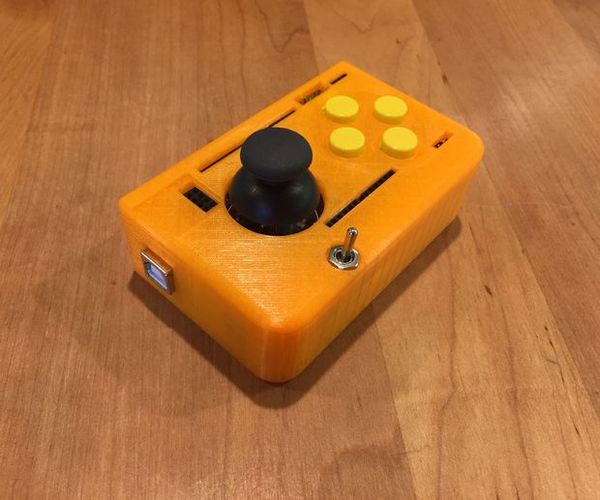
Universal Arduino Controller
"A few weeks after school got out I built a small Arduino robot. I wanted to move to the next step and I needed a controller. I started looking for a controller that let me choose what kind of signal to use but was unsuccessful. So I made my own. I own a NRF24L01+ module which is what I am going to use to control this robot but there is a place for a Bluetooth piece to attach. I cut space in the model to help make the NRF chip fit better and I may need to make similar changed to make room for Bluetooth modules Hardware in the controller." [...]
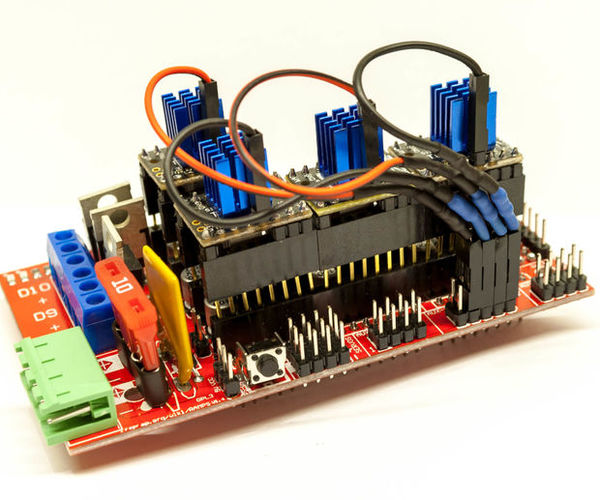
UART This! Serial Control of Stepper Motors With the TMC2208, Ramps 1.4 and Marlin
"Most people who are involved with DIY 3D printers or just like tinkering with a Maker-Grade commercial printer, will have heard of the Trinamic series of stepper motor driver chips. These little chips are making waves throughout the consumer and prosumer 3D printer markets due to their astonishing ability to render a 3D printer practically silent. The TMC2208 is also used by the German manufacturer Watterott in their SilentStepStick stepper motor driver product series. However, there is very little information written in layman's/Maker's terms regarding how to actually wire up this stepper motor driver board, to a traditional Ramps 1.4 to 1.6 style Arduino shield, in order to use the feature of serial communications over UART to control the stepper motors. In this Instructable, I will try to alleviate this by taking you through a step-by-step setup of how to use a TMC2208 based SilentStepStick in a UART configuration on your 3D printer. " [...]
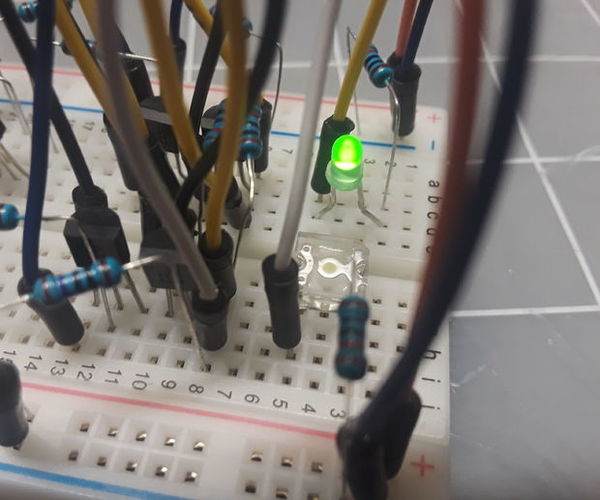
DIY SR Latch Out of Transistors
"An SR latch is a kind of circuit that is called "bistable." Bistable circuits have two stable states, hence the name BI-stable. One of the simpler versions of this kind of circuit is the SR latch, which stands for "Set/Reset Latch." The SR latch is most notably used for memory, because after you select a value, it is 'latched' so if there is no change in input, or the inputs turn off, the outputs stay the same. " [...]

Robotic Servo Arm
"We're going to make a robust robotic arm which can lift weights and move it. Lets get started with this cool stuff. " [...]
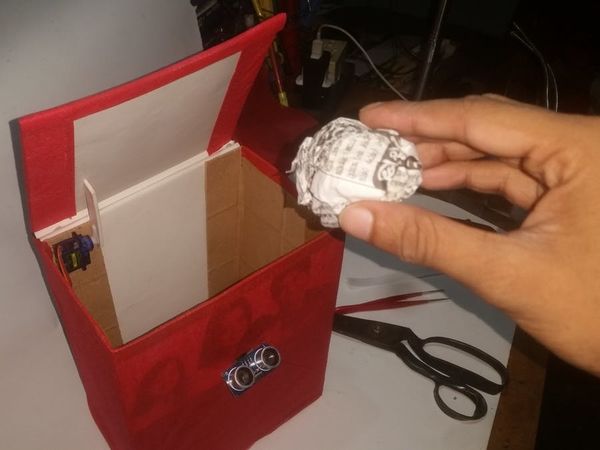
Arduino Trash-Bot (auto open close trash bin)
"An automatic trash -bot that opens its lid if it sees any trash and closes after a certain delay. Everything's getting smarter right? So why not your Trash Bin? This trash bin Opens and Closes its lid if it sees any Rubbish in front of it. You just need to bring the rubbish to it and it'll open automatically and will wait for you to feed it more then after a certain delay it'll close automatically. Watch the video to see exactly what it can do." [...]
That's all Folks!


